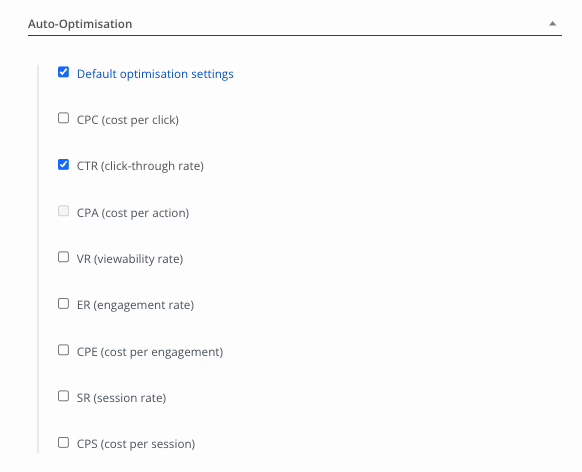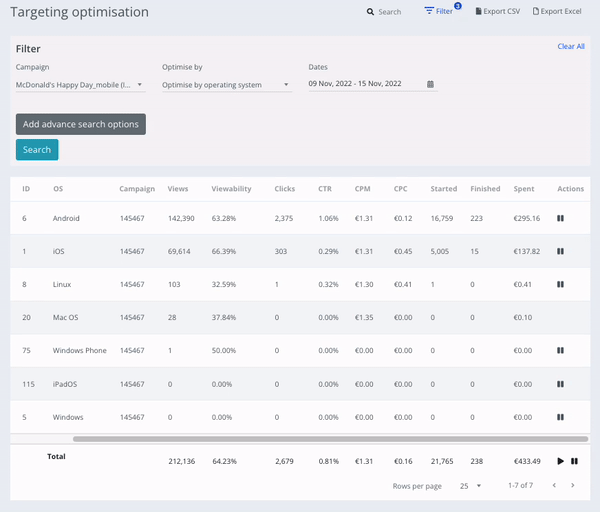Eskimi optimisation possibilities
The purpose of optimisation is to improve how well your company achieves its objectives. It involves modifying your advertising strategies in accordance with the data you collect. Eskimi DSP supports multiple optimisation techniques which can be used to make adjustments in campaigns. Using these possibilities you will be able to reach the performance which aligns with advertising goals.
The optimisation process itself can look like an easy task, however it is important not to get lost in multiple techniques and focus on the main campaign's goal (KPI). Therefore, it is essential to:
- set the right goals for your campaign
- determine important key performance indicators (KPIs) to measure progress
- use tools like Google Analytics (GA) to track and measure post click performance.
AutoEskimi optimisations: DSP auto-optimisation
mostAuto-optimisation commonis ones:commonly CPC,used CTR,for VR setting the campaign's objectives during the campaign's creation process. Determined auto-optimisation allows the system to analyze the placements based on the set objectives.
limitedAuto-optimisation due to low number of data: CPA
only possible when pixels are implemented: CPA, SR, CPS
not supported: ER, CPE
Auto optimisations workworks based on the indicated KPIobjective (minimum value), minimum impressions per placement to learn and minimum spend per placement to learn. That means that the system will bid on specific placements in order to determine if it meets autoauto-optimisation optimisation.values. If the placement will not meet the KPI,value, the system won't bid on it anymore.
It is possible to use default optimisation settings which are determined based on the benchmarks of specific markets. Specific optimisation values can be set as well if the campaign requires strictspecific KPI.objectives.
The stricter the optimisation will be used the more traffic will be filtered out, therefore it can strongly influence the spend of the campaign.
Auto-optimisation objectives differ based on the campaign's type. Display campaign support auto-optimisation based on: CPC (cost per click), CTR (click through rate), CPA (cost per action), VR (viewability rate), ER (engagement rate), CPE (cost per engagement), SR (session rate), CPS (cost per session). Video campaign support: CPC, CTR, CPA, MVTR (minimum view-through rate), CPCVV (cost per completed video view), VVR (video viewability rate), SR, CPS.
Limitations:
- CPA auto-optimisation is supported only once Eskimi conversion pixel is implemented.
- SR, CPS auto-optimisation is supported only once Eskimi audience pixel is implemented.
Manual optimisationsoptimisation (Targeting optimisation)
By exchangeBy creativeBy operating systemBy browserBy operatorBy app/site nameBy packageBy placement
The manual optimisation can be found on Eskimi DSP Targeting optimisation section. It allows to analyze the campaign's performance based(historical ondata) theby listed segments and by all performance metrics and optimize by pausing the individual elements such as creatives,specific exchanges,creative, sites.exchange, site.
Manual optimisation can be done by the following segments:
- exchange
- creative
- operating system
- browser
- operator
- app/site name
- package
- placement
Audience and conversion pixels
In order to track retargeting (site first party) audience, engaged sessions and conversions it is necessary to implement Eskimi tracking pixels on client'sthe website.landing page.
Implemented pixels allows usyou not only to see the metrics but also optimize on them which is significantly important. With implemented pixels weyou can see (just a few examples):
- from which websites or apps the conversions was made and based on that optimize the inventory
- what is the conversion rate of particular creative which allows
usto optimize on creatives - which browsers
generatesgenerate the most sessions which givesusopportunity to optimize onbrowser.browsers.
Audience and conversion pixels givesgive usyou multiple opportunities to optimize on better performance therefore it is strongly recommended to encourage all clients to implement them.them for multiple campaigns' objectives.
UTM
The UTM helps to indicate performance based on specific segment on Google Analytics side. For example UTM content part {site_id} is crucial if we want to see the performance on GA side by site and site id. This allows you to create the whitelist/blacklist based on the performance with specific site/app ids and use it in Eskimi DSP campaign.
By default ESKIMI UTMs includes:include:
UTM source - eskimi
UTM medium - cpm
UTM campaign - {campaign_title}
UTM term - {creative_size}
UTM content - eskimidsp_{site_id}
The UTMUTMs' helpsvalues toand indicatemacroses performancecan be also updated based on specific segment. For example UTM content part {site_id} is crucial if we want to see the performance on client's GA by site and by for example site id. needs.
It is a pretty common case that theGA clientreport complainshows abouta lowpoor performance of specific campaign in terms of session rate or highrate, bounce rate, howeveretc. usingwhile the landing page withoutof specificthat particular campaign does not have any UTMs. That means that theyou client isare not able to filter the performance by site id or any other segment,segment on GA side, therefore leaving usyou without any possibility to optimize.
Thethe most common and effective optimisation when talking about UTMs is basedcampaign on siteEskimi idsDSP (domains). If the campaign's landing page has UTM content {site_id}, the client can either share the GA report with performance of each site id or give us access to GA. This way we are able to create whitelists or blacklists and use them in the campaigns.side.
IAS, MOAT, DV
TheIntegral mentionedAd Science (IAS), MOAT, Double Verify (DV) trackers are most often used for tracking and evaluation of inventory and traffic quality, viewability evaluation.viewability. By default all these trackers evaluate performance perby domain. However, it is possible to have more segments such as campaign id, creative id and so on.more.
For example ourEskimi DSP IAS pixel includes: campaign id, site title, site id, creative size. These macroses indicatesindicate that wethere will be ablea possibility to analyze the performance by the mentioned splits and to optimize on those specific segments.
https://pixel.adsafeprotected.com/jload?anId=931059&advId=Eskimi&campId={campaign_id}&pubId={site_title}&chanId={site_id}&placementId={creative_size}them.


